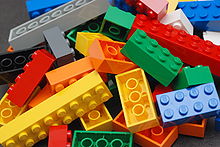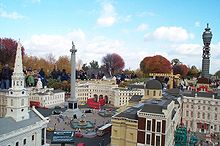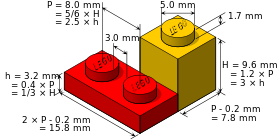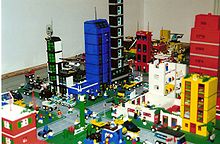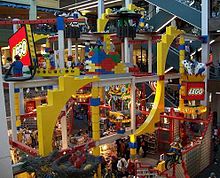- Lego
-
This article is about the construction toy. For the company, see Lego Group.
LEGO 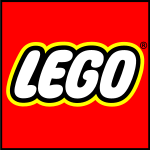
Type Construction set Inventor Ole Kirk Christiansen Company Lego Group Country Denmark Availability 1949–present Official website Lego (trademarked in capitals as LEGO) is a line of construction toys manufactured by the Lego Group, a privately held company based in Billund, Denmark. The company's flagship product, Lego, consists of colorful interlocking plastic bricks and an accompanying array of gears, minifigures and various other parts. Lego bricks can be assembled and connected in many ways, to construct such objects as vehicles, buildings, and even working robots. Anything constructed can then be taken apart again, and the pieces used to make other objects. The toys were originally designed in the 1940s in Denmark[1] and have achieved an international appeal, with an extensive subculture that supports Lego movies, games, video games, competitions, and five Lego theme amusement parks.
Contents
Early history
Main articles: History of Lego and Lego timelineThe Lego Group began in the workshop of Ole Kirk Christiansen (7 April 1891 – 11 March 1958), a carpenter from Billund, Denmark, who began making wooden toys in 1932.[2] In 1934, his company came to be called "Lego", from the Danish phrase leg godt, which means "play-well".
It expanded to producing plastic toys in 1947.[2] In 1949 Lego began producing the now famous interlocking bricks, calling them "Automatic Binding Bricks". These bricks were based largely on the patent[3] of Kiddicraft Self-Locking Bricks, which were released in the United Kingdom in 1947. Lego modified the design of the Kiddicraft brick after examining a sample given to it by the British supplier of an injection-molding machine that the company had purchased.[4] The bricks, originally manufactured from cellulose acetate,[4] were a development of traditional stackable wooden blocks that locked together by means of several round studs on top and a hollow rectangular bottom. The blocks snapped together, but not so tightly that they required extraordinary effort to be separated.
The Lego Group's motto is det bedste er ikke for godt which means roughly 'only the best is good enough' (more literally 'the best is never too good').[2] This motto was created by Ole Kirk to encourage his employees never to skimp on quality, a value he believed in strongly.[2] The motto is still used within the company today. The use of plastic for toy manufacture was not highly regarded by retailers and consumers of the time.[citation needed] Many of the Lego Group's shipments were returned after poor sales; it was thought that plastic toys could never replace wooden ones.[citation needed]
By 1954, Christiansen's son Godtfred Kirk Christiansen had become the junior managing director of the Lego Group. It was his conversation with an overseas buyer that struck the idea of a toy system. Godtfred saw the immense potential in Lego bricks to become a system for creative play but the bricks still had some problems from a technical standpoint: their locking ability was limited and they were not very versatile. In 1958, the modern brick design was developed but it took another five years to find the right material for it, ABS (acrylonitrile butadiene styrene) polymer.[4] The modern Lego brick was patented at 1:58 p.m on 28 January 1958;[5] bricks from that year are still compatible with current bricks.
Design
Lego pieces of all varieties comprise a universal system. Despite variation in the design and purpose of individual pieces over the years, each remains compatible in some way with existing pieces. Lego bricks from 1958 still interlock with those made in the current time, and Lego sets for young children are compatible with those made for teenagers.
Each Lego piece must be manufactured to an exacting degree of precision. When two pieces are engaged they must fit firmly, yet be easily disassembled. The machines that make Lego bricks have tolerances as small as 10 micrometre.[6]
Primary concept and development work takes place at the Billund headquarters, where the company employs approximately 120 designers. The company also has smaller design offices in the UK, Spain, Germany, and Japan, which are tasked with developing products aimed specifically at these markets. The average development period for a new product is around twelve months, in three stages. The first stage is to identify market trends and developments, including contact by the designers directly with the market; some are stationed in toy shops close to holiday periods, while others interview children. The second stage is the design and development of the product based upon the results of the first stage. As of September 2008 the design teams use 3D modeling software to generate CAD drawings from initial design sketches. The designs are then prototyped using an in-house stereolithography machine. These are presented to the entire project team for comment and for testing by parents and children during the "validation" process. Designs may then be altered in accordance with the results from the focus groups. Virtual models of completed Lego products are built concurrently with the writing of the user instructions. Completed CAD models are also used in the wider organization, such as for marketing and packaging.[9]
Manufacture
Since 1963, Lego pieces have been manufactured from a strong, resilient plastic known as acrylonitrile butadiene styrene (ABS). [10] As of September 2008, the engineers use the NX CAD/CAM/CAE PLM software suite to model the elements. The software allows the parts to be optimized by way of mold flow and stress analysis. Prototype molds are sometimes built before the design is committed to mass production. The ABS plastic is heated to 232 °C (450 °F) until at a dough-like consistency. It is then injected into the molds at pressures between 25 and 150 tons, and takes approximately 15 seconds to cool. The molds are permitted a tolerance of up to two micrometres, to ensure the bricks remain connected.[9] Human inspectors check the output of the molds, to eliminate significant variations in color or thickness. According to the Lego Group, about eighteen bricks out of every million fail to meet the standard required.[11] Lego factories recycle all but about 1 percent of their plastic waste from the manufacturing process every year. If the plastic cannot be re-used in Lego bricks, it is processed and sold on to industries that can make use of it.[12][13]
Manufacturing of Lego bricks occurs at a number of locations around the world. Molding is done in Billund, Denmark, Nyíregyháza, Hungary and Monterrey, Mexico. Brick decorations and packaging is done at plants in Denmark, Hungary, Mexico and Kladno in the Czech Republic. The Lego Group estimates that in the course of five decades it has produced some 400 billion Lego blocks.[14] Annual production of Lego bricks averages approximately 36 billion per year, or about 1140 elements per second. If all the Lego bricks ever produced were to be divided equally among a world population of six billion, each person would have 62 Lego bricks.[15] According to an article in BusinessWeek in 2006, Lego could be considered the world's No. 1 tire manufacturer; the factory produces about 306 million tiny rubber tires a year.[16]
Today
 Lego building at NASA's KSC.
Lego building at NASA's KSC.
Since it began producing plastic bricks, the Lego Group has released thousands of sets with a variety of themes, including town and city, space, robots, pirates, trains, Vikings, castle, dinosaurs, undersea exploration, and wild west.
New elements are often released along with new sets. There are also Lego sets designed to appeal to young girls such as the Belville and Clikits lines which consists of small interlocking parts that are meant to encourage creativity and arts and crafts, much like regular Lego bricks. Belville and Clikit pieces can interlock with regular Lego bricks as decorative elements.
While there are sets which can be seen to have a military theme – such as Star Wars, the German and Russian soldiers in the Indiana Jones sets, the Toy Story green soldiers and Lego Castle – there are no directly military-themed sets in any line. This is following Ole Kirk Christiansen's policy of not wanting to make war seem like child's play.
The Lego range has expanded to encompass accessory motors, gears, lights, sensors, and cameras designed to be used with Lego components. Motors, battery packs, lights and switches are sold under the name Power Functions. The Technic line utilizes newer types of interlocking connections that are still compatible with the older brick type connections. The Technic line can often be motorized with Power Functions.
Bionicle is a line of toys by the Lego Group that is marketed towards those in the 7–16 year-old age range. The line was launched in January 2001 in Europe and June/July 2001 in the United States. The Bionicle idea originated from the earlier toy lines Slizers (also known as Throwbots) and Roboriders. Both of these lines had similar throwing disks and characters based on classical elements. The sets in the Bionicle line have increased in size and flexibility through the years. Bionicle was replaced with Hero Factory in 2010.
The Lego group's Duplo product line, introduced in 1969, is a range of simple blocks which measure twice the width, height and depth of standard Lego blocks, and are aimed at younger children.
'Fabuland' ran from 1979 to 1989. The more advanced 'Lego Technic' was launched in 1977. 'Lego Primo' is a line of blocks by the Lego Group for very young children that ran between 2004 and 2006. In 1995 'Lego Baby' was launched for babies.
One of the largest Lego sets ever commercially produced is a minifig-scaled edition of the Star Wars Millennium Falcon. Designed by Jens Kronvold Fredericksen, it was released in 2007 and has 5,195 pieces. It was surpassed, though, by a 5,922 piece Taj Mahal.[17]
In May 2011, Space Shuttle Endeavour mission STS-134 brought 13 Lego kits to the International Space Station, where astronauts will build models and see how they react in microgravity, as part of the Lego Bricks in Space program. The results will be shared with schools as part of an educational project.[18][19]
Licensed themes
Further information: List of Lego themesOver the years, Lego has licensed themes from several cartoon and film franchises. These include Avatar: The Last Airbender, Batman, Ben 10, Cars, Harry Potter, Indiana Jones, Pirates of the Caribbean, Prince of Persia, Speed Racer, Spider-Man, SpongeBob SquarePants, Star Wars, Thomas the Tank Engine, and Toy Story.
Although some of the licensed themes, such as Lego Star Wars and Lego Indiana Jones, have had highly successful sales, Lego has expressed a desire to rely more upon their own characters and classic themes, and less upon licensed themes related to movie releases.[20]
Robotics sets
Lego initiated a robotics line of toys called 'Mindstorms' in 1998, and has continued to expand and update this range ever since. The roots of the product originate from a programmable brick developed at the MIT Media Lab, and the name is taken from a paper by Seymour Papert, a computer scientist and educator who developed the educational theory of constructionism, and whose research was at times funded by the Lego Group.
The programmable Lego brick which is at the heart of these robotics sets has undergone several updates and redesigned, with the latest being called the 'NXT' brick, being sold under the brand name of Lego Mindstorms NXT 2.0. The set includes sensors that detect touch, light, sound and ultrasonic waves, with several others being sold separately, including an RFID reader.
The intelligent brick can be programmed using official software available for Windows and Mac computers, and is downloaded onto the brick via Bluetooth or a USB cable. There are also several unofficial programs and compatible programming languages that have been made to work with the brick, and many books have been written to support this community.
There are several robotics competitions which use the Lego robotics sets. The earliest is Botball, a national U.S. middle- and high-school competition stemming from the MIT 6.270 Lego robotics tournament. Other Lego robotics competitions include Junior FIRST LEGO League (Jr.FLL) for students ages 6-9, and FIRST Lego League (FLL) for students ages 9-14. Jr.FLL and FLL offer real-world engineering challenges to participants. FLL uses Lego-based robots to complete tasks. Jr.FLL participants build models out of Lego elements. In its 2010 season, there were 16,070 FLL teams in over 55 countries. In its 2010 season, there were 2,147 Jr.FLL teams with 12,882 total student participants in the United States and Canada[21] The international RoboCup Junior football competition involves extensive use of Lego Mindstorms equipment which is often pushed to its extreme limits.
Related products and services
The Lego Group has used the Lego toy system to branch out into a number of other areas.
Video games
Main article: List of Lego video gamesLego has branched out into the videogames market with a number of titles, including Lego Star Wars: The Video Game, Lego Star Wars II: The Original Trilogy, Bionicle: The Game Bionicle Heroes as well as the Lego Star Wars: The Complete Saga and Lego Indiana Jones, a Lego Batman, Lego Battles and the Lego Universe MMOG. Lego Harry Potter: Years 1–4 was released in June 2010, and Lego Rock Band was released in autumn[when?] of 2009. Another game announced is Lego Indiana Jones 2: The Adventure Continues including Indiana Jones and the Kingdom of the Crystal Skull and total remakes of the other movie's levels was released in 2009. More Lego video games are Lego Star Wars III: The Clone Wars, based on the first and second seasons of The Clone Wars and "Lego Battles: Ninjago" based on the short video clips on the website. The newest addition to the LEGO video game series is Lego Pirates of the Caribbean: The Video Game, where you can play all four movies including Pirates of the Caribbean: On Stranger Tides.
Lego Digital Designer is an official piece of Lego software for Mac OS X and Windows which allows users to build with Lego bricks on their computers. Users can then publish their creations online on the Lego Design by Me website, or purchase the physical bricks to build them. Lego Digital Designer includes some Lego products which only exist online, including models for the children's television programs TUGS, Thomas and Friends and Speed Racer.
Official website
Main article: Lego.comFirst launched in 1996, the Lego website has developed over the years, and provides many extra services beyond a shop and product catalog. There are moderated message boards, founded in 2001.
My Lego Network is a social networking site that involves items, blueprints, ranks, badges which are earned for completing certain tasks, trading and trophies called masterpieces which allow users to progress to go to the next rank. The website has a built in inbox which allows users to send prewritten messages to one another. The Lego Network includes automated non-player characters within called "Networkers", who are able to do things which normal users cannot do, such as sending custom messages, and selling masterpieces and blueprints. The site also has modules which are set up on the user's page to 'grow' certain things,[clarification needed] for showing picture compositions or both. The site includes instructions booklets for all Lego sets dating back to 2002.
Business consultancy
Main article: Lego Serious PlaySince around 2000, the Lego Group has been promoting 'Lego Serious Play', a form of business consultancy fostering creative thinking, in which team members build metaphors of their organizational identities and experiences using Lego bricks. Participants work through imaginary scenarios using visual three-dimensional Lego constructions, imaginatively exploring possibilities in a serious form of play.
Theme parks
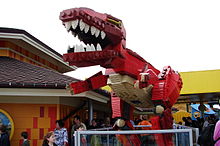 Tyrannosaurus rex model outside the LEGO store at Downtown Disney in Orlando
Tyrannosaurus rex model outside the LEGO store at Downtown Disney in Orlando Main article: Legoland
Main article: LegolandMerlin Entertainments operates five Legoland amusement parks, the original in Billund, Denmark, the second in Windsor, England, the third in Günzburg, Germany, the fourth in Carlsbad, California, and the fifth in Winter Haven, Florida. On 13 July 2005, the control of 70% of the Legoland parks was sold for $460 million to the Blackstone Group of New York while the remaining 30% is still held by Lego Group. There are also four Legoland Discovery Centers,[22] two in Germany (Duisburg and Berlin), one in Chicago, Illinois, and one in Manchester, UK. Two new Legoland Discovery Centers are scheduled to open in 2011: one in Dallas, Texas.[23][24] Another will open in Kansas City in 2012.[25]
Retail stores
Lego operates 46 retail stores (34 in the United States, five in the United Kingdom, five in Germany, one in Canada, and one in Denmark), including ones at the Downtown Disney shopping complexes at Disneyland and Walt Disney World Resorts as well as in the Mall of America in Bloomington, Minnesota. On 24 November 2010, a Lego retail store was opened in Lima, Peru,[26] at Jockey Plaza Shopping Center.[27] The opening of each store is celebrated with weekend long event where a Master Model Builder creates, with the help of volunteers most of who are children, a larger than life Lego statue which is then displayed at the new store for several weeks.[28]
Three of the recently opened Lego stores incorporate a new idea for the Lego retail side called Lego education. At these three stores (which are located in Concord North Carolina, Hanover Maryland, and Berlin Germany) there are separate areas to the side of the store that are used as classrooms where specially trained facilitators teach children ranging from 4–12 years old about numerous different subjects while using Lego product. This new concept is being tested, and has only been around for about 8 months.[29]
Children's clothes
Since 1993 LEGOwear Clothes have been produced and marketed by a Danish company called Kabooki under license from Lego Group. The clothes are for boys and girls from 0–12 years old and the partnership also ties in with other Lego products such as Bionicle.
Board games
Main article: Lego board gamesLego Games launched in 2009–2010, and is a series of Lego-themed board games designed by Cephas Howard and Reiner Knizia[30][31] in which the players usually build the playing board out of Lego bricks and then play with Lego-style players. Some of the games are Race 3000, Wild Wool, Minotaurus, Magikus, Monster 4, Lava Dragon, Pirate Code, Ramses Pyramid, Atlantis Treasure, Robo Champ, Orient Bazaar, and Creationary. Like many board games, the games utilize dice. However, in Lego Games, the die is Lego, with Lego squares with symbols on Lego studs on the die. The games vary from simple to complex, some are similar to "traditional" board games, while others are completely different.
Films and television
Main article: List of Lego filmsIn the past, Lego has turned down approaches from Hollywood to make a feature-length film based on the toy. However, this stance has since softened. A number of straight-to-DVD computer animated Bionicle and Hero Factory movies have been produced. A movie called LEGO: The Adventures of Clutch Powers was released on DVD in February 2010. This was a completely computer-animated film made by Tinseltown Toons. It is a crossover movie comprising many Lego themes.[32]
A feature film adaptation of the Lego world has been in development at Warner Bros. since 2008.[33] In August 2009, it was announced that Dan and Kevin Hageman were writing the script for a comedy action adventure live-action/animated film.[34] Phil Lord and Chris Miller were hired in June 2010, to write and direct the film.[35] In November 2011, it was reported that Warner Bros. has green-lighted the film, with a schedule to release it in 2014. Australian Animal Logic will provide the animation, which is expected to comprise 80% of the film. Chris McKay, the director of Robot Chicken, has also joined Lord and Miller to co-direct the film.[33]
Books and magazines
Lego has an ongoing deal with publisher Dorling Kindersley (DK), who are producing a series of illustrated hardback books looking at different aspects of the construction toy. The first was The Ultimate Lego Book, published in 1999. More recently, in 2009, the same publisher produced The LEGO Book, which was sold within a slipcase along with Standing Small: A celebration of 30 years of the LEGO minifigure, a smaller book focused on the minifigure. In same year, DK also published books on Lego Star Wars (Lego Star Wars: The Visual Dictionary) and a range of Lego-based sticker books.
Although no longer being published in the United States by Scholastic, books covering events in the BIONICLE storyline are written by Greg Farshtey. They are still being published in Europe by AMEET. BIONICLE comics, also written by Farshtey, are compiled into graphic novels and were released by Papercutz.[36] This series ended in 2009, after nine years. There is also the Lego Club and Brickmaster magazine.
In popular culture
Main article: Lego in popular cultureLego's popularity is demonstrated by its wide representation and usage in many forms of cultural works, including books, films and art work. It has even been used in the classroom as a teaching tool.[37] In the USA, LEGO Education North America is a joint venture between Pitsco, Inc. and the educational division of the LEGO Group.[38]
In 1998, Lego bricks were inducted into the National Toy Hall of Fame at The Strong in Rochester, New York.
References
- ^ Willy Horn Hansen. 50 Years of Play. The Lego Group, 1982, p. 25.
- ^ a b c d Lipkowitz, Daniel (2009) [2009]. The LEGO Book. London: Dorling Kindersley. ISBN 978-1-405304169-1.
- ^ "Improvements in toy building blocks, patent GB529580 of 25 November 1940 by Harry Fisher Page of Kiddicraft". espacenet.com. 17 July 2010. http://v3.espacenet.com/publicationDetails/biblio?CC=GB&NR=529580&KC=&FT=E. Retrieved 17 July 2010.
- ^ a b c May, James (2009) [2009]. James May's Toy Stories. London: Conway. ISBN 9781844861071.
- ^ "Lego Celebrates 50 Years of Building". TIME. 28 January 2008. http://www.time.com/time/world/article/0,8599,1707379,00.html. Retrieved 28 January 2008.
- ^ "Company Profile An Introduction to the LEGO Group 2010" (PDF). The LEGO Group. 2010. p. 20. http://cache.lego.com/upload/contentTemplating/AboutUsFactsAndFiguresContent/otherfiles/download98E142631E71927FDD52304C1C0F1685.pdf. Retrieved 21 May 2011.
- ^ "Lego Specifications". Orionrobots.co.uk. 26 February 2011. http://orionrobots.co.uk/Lego+Specifications. Retrieved 2011-10-03.
- ^ Dimensions Guide (13 December 2010). "Dimensions of a Standard Lego Brick". Dimensionsguide.com. http://www.dimensionsguide.com/dimensions-of-a-standard-lego-brick. Retrieved 2011-10-03.
- ^ a b Frances Corbet (September 2008). "Child's Play". Develop 3D (X3DMedia): 25–27.
- ^ "Page 18 of the Lego company profile document". lego.com. http://www.lego.com/info/pdf/LEGO_company_profile_UK.pdf. Retrieved 12 May 2007.
- ^ "Company Profile An Introduction to the LEGO Group 2010" (PDF). The LEGO Group. 2011. p. 8. http://cache.lego.com/upload/contentTemplating/AboutUsFactsAndFiguresContent/otherfiles/download98E142631E71927FDD52304C1C0F1685.pdf. Retrieved 21 May 2011.
- ^ "Everything You Always Wanted to Know About Lego". Gizmodo.com. 26 June 2008. http://gizmodo.com/5019797/everything-you-always-wanted-to-know-about-lego. Retrieved 29 May 2010.
- ^ "How Lego Bricks Work". HowStuffWorks.com. http://entertainment.howstuffworks.com/lego.htm. Retrieved 13 May 2007.
- ^ Cendrowicz, Leo (28 January 2008). "Lego Celebrates 50 Years of Building". TIME. http://www.time.com/time/world/article/0,8599,1707379,00.html. Retrieved 26 September 2010.
- ^ "Lego Group to outsource major parts of its production to Flextronics". lego.com. http://www.lego.com/eng/info/default.asp?page=pressdetail&contentid=20727&countrycode=2057&yearcode=2006&archive=true. Retrieved 12 May 2007.
- ^ "The Making of…a LEGO". Bloomberg BusinessWeek. 29 November 2006. http://www.businessweek.com/bwdaily/dnflash/content/nov2006/db20061127_153826.htm. Retrieved 28 July 2010.
- ^ Meno, George (7 June 2008). "Designing General Grievous". brickjournal.com. Archived from the original on 14 June 2008. http://web.archive.org/web/20080614024128re_/brickjournal.com/news/2008/6/7/interview-with-lego-designer. Retrieved 6 September 2008.
- ^ Banks, Dave (28 April 2011). "Space Shuttle Endeavour Launches Tomorrow With a Special Payload". Wired News. http://www.wired.com/geekdad/2011/04/space-shuttle-endeavor-launches-tomorrow-with-a-special-payload/. Retrieved 2 May 2011.
- ^ Eaton, Kit (29 April 2011). "Space Shuttle Endeavour: Made Of Spare Parts". Fast Company. http://www.fastcompany.com/1750642/space-shuttle-endeavour-the-spare-parts-spaceship. Retrieved 2 May 2011.
- ^ "MINDSTORMStm and Harry Potter will continue" (Press release). Lego Group. 14 January 2004. http://www.lego.com/eng/info/default.asp?page=pressdetail&contentid=3423. Retrieved 12 January 2009.
- ^ "USFIRST.org". USFIRST.org. http://www.usfirst.org. Retrieved 2011-10-03.
- ^ "Legoland Discovery Centre". Legolanddiscoverycenter.com. http://www.legolanddiscoverycenter.com/default.aspx. Retrieved 29 May 2010.
- ^ "The LEGOLAND Discovery Centre, Manchester – an adventure in the making!". Legolanddiscoverycentre.co.uk. 19 April 2010. http://www.legolanddiscoverycentre.co.uk/manchester/en/index.htm. Retrieved 29 May 2010.
- ^ "The Legoland discovery center, Dallas and Fort Worth – an adventure in the making". The LEGO Group. 11 December 2010. http://www.legolanddiscoverycenter.com/dallasfw/en/index.htm.
- ^ "Legoland Coming to Kansas City's Crown Center". fox4kc.com. http://www.fox4kc.com/news/wdaf-legoland-coming-to-kansas-citys-crown-center-20110509,0,4861167.story. Retrieved 5 August 2011.
- ^ "New Lego Store opens in Lima at Jockey Plaza Shopping Center (in Spanish)". El Comercio. 1 December 2010. http://elcomercio.pe/lima/677813/noticia-primera-tienda-lego-peru-tiene-como-emblema-tumi-armable-bloques.
- ^ "Jockey Plaza Shopping Center website". Jockey-plaza.com.pe. http://www.jockey-plaza.com.pe/. Retrieved 2011-10-03.
- ^ "Grown-up lives in LEGO Land". News and Observer. 24 May 2009. http://www.newsobserver.com/business/story/1539233.html.
- ^ . http://stores.lego.com/en-us/Hanover/LandingPage.aspx.
- ^ Gilbert, Brett J. (12 July 2009). "LEGO Board Games: Interview with Cephas Howard". BrettSpiel. http://www.brettspiel.co.uk/2009/07/lego-board-games-interview-with-cephas.html. Retrieved 24 August 2009.
- ^ "LEGO Games". http://games.lego.com/en-us/default.aspx?domainredir=www.games.lego.com.
- ^ "LEGO.com LEGO Club : News & Extras". Club.lego.com. 23 February 2010. http://club.lego.com/en-us/news/ExtraDetails.aspx?id=150337. Retrieved 29 May 2010.
- ^ a b McNary, Dave (11 November 2011). "Warners greenlights 'Lego' feature". Variety. http://www.variety.com/article/VR1118046055. Retrieved 12 November 2011.
- ^ Graser, Marc (11 August 2009). "Warner builds pic with Lego". Variety. http://www.variety.com/article/VR1118007162. Retrieved 12 November 2011.
- ^ McNary, Dave (28 June 2010). "'Cloudy' directors toy with 'Lego'". Variety. http://www.variety.com/article/VR1118021180. Retrieved 12 November 2011.
- ^ "Bionicle". Papercutz.com. http://www.papercutz.com/bionicle/index.html. Retrieved 2011-10-03.
- ^ Chan, Derek. "Lego Educational Resource". Blogger. http://legoeducationalresource.blogspot.com. Retrieved 2011 09 03.
- ^ "Lego Education (see footnote)". http://www.legoeducation.us/.
Further reading
- Bagnall, Brian. "Maximum LEGO NXT: Building Robots with Java Brains". Variant Press. 2007. ISBN 0-9738649-1-5
- Bagnall, Brian. "Core LEGO Mindstorms". Prentice-Hall PTR. 2002. ISBN 0-13-009364-5
- Bedford, Allan. The Unofficial LEGO Builder's Guide. San Francisco: No Starch Press, 2005. ISBN 1-59327-054-2.
- Clague, Kevin, Miguel Agullo, and Lars C. Hassing. LEGO Software Power Tools, With LDraw, MLCad, and LPub. 2003. ISBN 1-931836-76-0
- Courtney, Tim, Ahui Herrera and Steve Bliss. Virtual LEGO: The Official LDraw.org Guide to LDraw Tools for Windows. San Francisco: No Starch Press, 2003. ISBN 1-886411-94-8.
- McKee, Jacob H. Getting Started with LEGO Trains. San Francisco: No Starch Press, 2003. ISBN 1-59327-006-2.
- Ferrari, Mario, Giulio Ferrari, and Ralph Hempel. Building Robots With LEGO Mindstorms: The Ultimate Tool for Mindstorms Maniacs. 2001. ISBN 1-928994-67-9.
- Kristiansen, Kjeld Kirk, foreword. The Ultimate LEGO Book. New York: DK Publishing Book, 1999. ISBN 0-7894-4691-X.
- Wiencek, Henry. The World of LEGO Toys. New York: Harry N. Abrams, Inc., Publishers, 1987. ISBN 0-8109-2362-9.
- Pilegaard, Ulrik, and Dooley, Mike. "Forbidden LEGO". San Francisco: No Starch Press, 2007. ISBN 1-59327-137-9
- Willicense, Fransisco. "The LEGO Incorporation: How LEGO Started" ISBN 0-18361-46372
External links
Listen to this article (info/dl)
This audio file was created from a revision of Lego dated 2006-02-12, and does not reflect subsequent edits to the article. (Audio help)More spoken articles Media related to Lego at Wikimedia Commons
Media related to Lego at Wikimedia Commons- Lego Official website
The LEGO Group Product ranges Current themesAlien Conquest · Architecture · Atlantis · Cars · Castle · City · Creator · Duplo · Games · Harry Potter · Hero Factory · Mindstorms · Minifigures · Modular Houses · Ninjago · Pharaoh's Quest · Pirates of the Caribbean · Racers · SpongeBob SquarePants · Star Wars · Technic
Discontinued4+ · Agents · Adventurers · Alpha Team · Aqua Raiders · Aquazone · Avatar: The Last Airbender · Baby · Batman · Belville · Ben 10: Alien Force · Bionicle · Dino Attack · Exo-Force · Fabuland · Indiana Jones · Mars Mission · Mickey Mouse · Ninja · Pirates · Power Miners · Prince of Persia: The Sands of Time · Quatro · Rock Raiders · Slizer/Throwbots · Spider-Man · Sports · Studios · Time Cruisers · Toy Story · Vikings · Wild West · World Racers
Other productsVideo games · Board games · Design By Me · Films · Serious Play
People Legoland Legoland Billund · Legoland California · Legoland Deutschland · Legoland Florida · Legoland Windsor · Legoland Discovery Centre
Events BrickCon · BrickFair · BrickFest · Brickworld · FIRST Lego League · Junior FIRST Lego League · Robofest
Other topics Categories:- Lego
- 1949 introductions
- Construction toys
- Danish brands
- Danish design
- National Toy Hall of Fame inductees
- Toy companies of Denmark
- Toy train manufacturers
Wikimedia Foundation. 2010.

